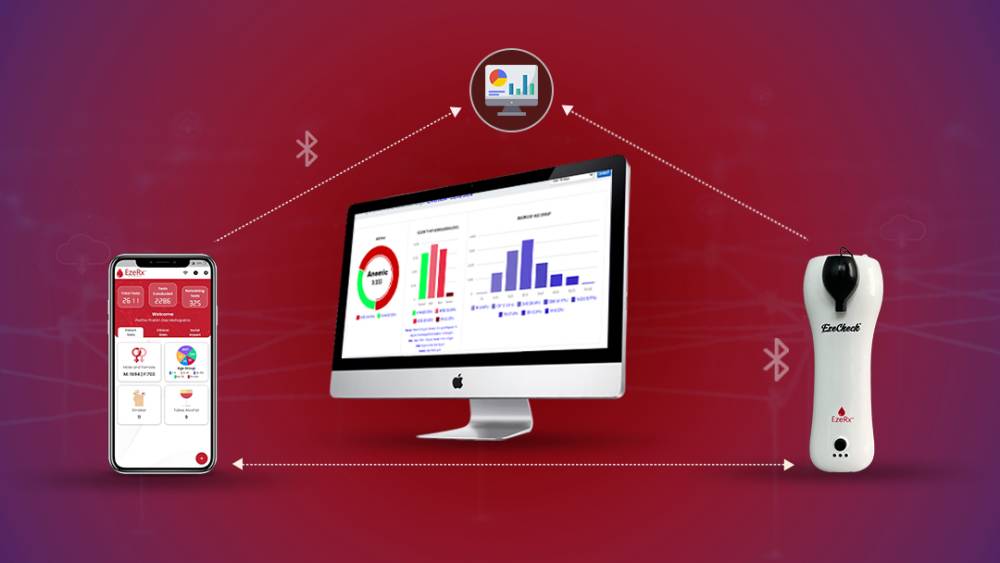
Anemia is a condition caused by a deficiency in red blood cells containing a protein called hemoglobin, which is responsible for delivering oxygen to the body's tissues. It is a global public health issue, particularly in developing countries like India, due to factors such as malnutrition.
According to a study published in The Lancet Haematology, nearly 2 billion people worldwide are affected by anemia. The fifth round of the National Family Health Survey conducted between 2019 and 2021 revealed a significant increase in anemia levels across all age groups in India. The study found that more Indians are affected by anemia than ever before, with at least 67% of children now having the condition compared to 58.6% in the previous survey conducted in 2015-16. On the other hand, the World Bank data indicates that one in two Indian women is anemic, which is 20% higher than the global average.
To address this issue, early detection is crucial. EzeCheck brings a ray of hope to this grave situation. It is India's first ICMR-RMRC-validated blood-free hemoglobin screening device that offers an opportunity to utilize the Internet of Things (IoT) for accessible and efficient anemia management. This blog aims to explore the potential benefits of using EzeCheck as an IoT device in healthcare and discuss the results obtained from its usage.
The term 'Internet of Things' was invented by Kevin Ashton, a British-born technology pioneer, while he was working at Procter & Gamble in 1999. Ashton, considered the father of IoT, envisioned a future where everyday physical items would be connected to the internet, allowing them to identify themselves with other devices. Now, let's find out what the Internet of Things, or IoT, is. In simple terms, IoT can be defined as "anything, anytime, anywhere." According to McKinsey, IoT is described as "sensors and actuators embedded in physical objects that are linked through wired and wireless networks, often using the same Internet Protocol (IP) that connects the Internet."
Nowadays, IoT has gained significant popularity, but the concept dates back decades. In 1990, John Romkey created the first smart toaster that could be controlled via the internet, which he showcased at the INTEROP conference. However, the idea of connected devices was proposed in the 1970s with the introduction of telemetry, followed by Module2Module systems, which evolved into IoT after 2010. The use of sensors in IoT devices started around 2013–14, and by 2017, IoT devices were widely used, with an estimated 8.4 billion IoT devices in use.
The Internet of Things (IoT) entered the healthcare sector in 2018, giving medical professionals access to patient data and enhancing the quality of medical equipment. Currently, it is leading the way in the digital revolution that the healthcare sector is going through. The Internet of Things in the healthcare sector reached an impressive 181.4 billion USD in 2022. However, that was only the beginning. According to the experts, this industry will boom at an astounding rate, reaching a staggering 952.3 billion USD by 2032. This remarkable growth is accompanied by an impressive CAGR of 18.0%.
IoT-enabled medical devices like EzeCheck play a crucial role in the healthcare industry. This device operates seamlessly with the EzeCheck app. While doing hemoglobin tests via this cutting-edge device, doctors can input patient details into the app and start testing instantly. Results are generated within 60 seconds and stored in EzeCheck's interactive dashboard, benefiting both doctors and patients. By integrating IoT capabilities, EzeCheck has transformed into a smart healthcare tool. The device connects to a secure network, such as Bluetooth, and automatically transmits readings to the EzeCheck dashboard, which is a designated cloud platform. These records are used for data analysis to identify trends, predict potential issues, and guide personalized treatment plans. With EzeCheck, healthcare providers can access patient data remotely, enabling continuous monitoring of hemoglobin levels and improving patient care.
EzeCheck leverages the Internet of Things (IoT) to bring significant benefits. For example, in a remote village in India, EzeCheck can quickly screen hemoglobin levels and detect anemia within a minute. This data can then be instantly transmitted to a doctor anywhere in the world using IoT. The doctor can review the data and initiate a tailored treatment plan in a very short time, a process that previously took many days.
Moreover, a pregnant woman can use EzeCheck to track her hemoglobin levels. The data from her tests will be stored in our dashboard through IoT. Should she suddenly become anemic, caregivers can compare the data to determine when she became anemic, helping to identify the cause.
Improved Patient Care: EzeCheck monitors patients in real time and stores their data in an interactive dashboard. Caregivers can use this data to create tailored treatment plans for the patients.
Enhanced Remote Care: Healthcare professionals can efficiently manage patients in any corner of the globe thanks to remote access to data.
Patient Empowerment: Users are able to monitor their readings and access valuable insights into their health, promoting self-care and well-informed decision-making.
Early Detection: Automated analysis can detect potential anemia earlier, enabling preventive measures and improved long-term health outcomes.
Transforming EzeCheck into an IoT device holds immense potential in the fight against anemia. By offering a blood-free, quick, and reliable way to monitor hemoglobin levels, EzeCheck improves patient care and simplifies anemia management, particularly in remote areas. The device's ability to instantly transmit data and provide real time analysis empowers both patients and healthcare providers. This leads to earlier detection and more effective treatment plans. EzeCheck also promotes patient engagement by providing valuable health insights and enabling informed decision-making. As we continue to embrace such innovations, the future of healthcare looks promising, with better health outcomes and more accessible care for everyone. By leveraging IoT, EzeCheck not only revolutionizes anemia management but also sets a precedent for future medical technologies, ensuring a healthier and more connected world.-